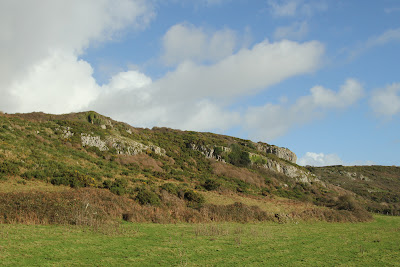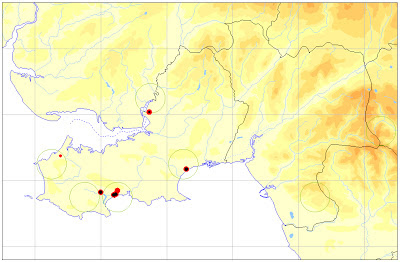Mike Kirby photographed this flock of 21 Waxwings outside his house today after they fed on berries in his garden in Killay. Sounds like they may have moved on as he only saw them for a total of five minutes. There are over 120 in Cardiff at present so do look out for this species, there will be plenty to follow for sure...
30 November 2012
28 November 2012
26 November 2012
Juniper, Butcher's Broom and a very small moss
 |
| cliffs between Horton and Slade where Juniper, Butcher's Broom and Starke's Pottia grows |
 |
| Juniper |
 |
| Butcher's Broom |
In the same habitat the tiny Starke's Pottia (Microbryum starckeanum) was found fruiting this weekend. This is an uncommon species that likes thin lime-rich soils and the height of these plants, including capsules, is less than 5mm. Note the tiny basal rosette of leaves are mostly hidden by the leaves of larger species in the photo below.
23 November 2012
Polypody sp at Crawley Bluff
The polypody ferns are at their best at this time of year and can be found on walls, tree trunks or dune ridges. In addition to Western Polypody (Polypodium interjectum) which is abundant on the dunes, there are some very good patches of Southern Polypody (P. cambricum) growing on trees in the woodland and scrub below and to the east of Crawley Bluff (voucher at NMW). However, it is unusual for Southern Polypody to grow on the ground and I have suspicions the hybrid (P. x shivasiae) might explain these seemingly intermediate plants noted under scrub below the bluff. Collection of material with ripe spores later in the season will hopefully resolve the matter.
Spindle (Euonymus europaeus) is frequent in the woods in this area and its distinctive seed capsules make it particularly prominent at this time of year.
Nearby, bryophytes growing in profusion on a damp north-facing dune cliff included Wall Scalewort (Porella platyphylla) and Long-beaked Thyme-moss (Plagiomnium rostratum).
 |
| distribution of Southern Polypody |
 |
| distribution of Western Polypody |
Nearby, bryophytes growing in profusion on a damp north-facing dune cliff included Wall Scalewort (Porella platyphylla) and Long-beaked Thyme-moss (Plagiomnium rostratum).
.jpg) |
| Wall Scalewort |
 |
| Long-beaked Thyme-moss |
22 November 2012
Gower Ornithological Society AGM
+Whiteford+24Dec11.jpg) |
| (c) M. Hipkin |
09 November 2012
Is the Ash destined to follow the Elm and the Larch?
This magnificent Dutch Elm (Ulmus x hollandica), with a 4.05m girth, standing at the entrance to Rhydgoch Cemetery in Pontarddulais, clearly has suffered little ill effect from the ravages of Dutch Elm Disease. One of the reasons why English Elm (U. procrea) is said to have been so badly affected during the outbreak in the 1970’s was the lack of genetic diversity - the species does not to reproduce well sexually, being largely cloned from limited stock brought in during Roman times. By way of contrast, the Ash is far more sexually active. A higher level of genetic diversity should in theory improve the chances of more trees being resistant to the pathogenic effects of the fungus Chalara fraxinea, but predicting the level of impact it will have on our Ash woods and specimen trees seems likely to remain a subject of much debate. The best article I have seen so far on this topic can be found from the following link: Ash Dieback BSBI
With the dramatic reduction of Larch and now possibly Ash from our landscape, interesting times lie ahead. What will the status of the Gower Ash Woods Special Areas of Conservations be in 10 or 20 years time? I remain optimistic there will still be a lot of interest there - deadwood invertebrates could be worth studying before the situation changes!
The Kingfisher
 |
| Adult male has all black bill |
Here in Gower, now is one of the best times to see these great little birds, there are two main reasons for this; the first being that many of the inland birds move down to the coast for the winter, where the temperature can be one or two degrees higher, this may not sound like much but it can make the difference between the water ways freezing or not, which to a kingfisher may mean life or death, the second is simply with the loss of leaves and the die back of water side vegetation they are just easier to spot.
 |
| Female has orange lower mandible |
So next time you’re out and about near any of our local waters and you catch a glimpse of this wonderful bird, take the time and find somewhere out of the way, sit down quietly, watch and wait, you may be there for some time, but not always and if you are lucky enough to see a Kingfisher at close quarters it's something you will never forget.
All photos (c) Paul Tyrrell
08 November 2012
Larch.... the swan song ?
There are some spectacular autumn colours this year and larch, which never disappoints, is particularly striking in the Neath and Afan Valleys at the moment. The photo above was taken today, looking west down the River Afan towards Rhyslyn near Pontrhydyfen. I love the way the golden larch canopies bring the darker coloured spruces and pines into relief. None of the other conifers in our plantations support such a rich biodiversity of plants and lichens. These deciduous forests have been a sanctuary for wood warblers, a surrogate home for bluebells and usually become carpeted with bryophytes more typical of upland oak woodland as they mature. The light and 'airy' nature of larch woods also provides ideal conditions for lichens, like Parmelia perlata (below) and Usnea subfloridana which often cover the twigs and branches.
And even in a poor year for toadstools, there's always some Larch Bolete (Suillus grevillei) to be found.
If you take a drive along the A465 to Glyn Neath, you'll get a good picture of the amount of larch forest that is bedded into the Neath Valley. Its removal (or death) will reveal a radically different landscape - you don't know what you've got 'til it's gone!
Forty years ago I had mixed feelings (mostly negative) about conifer plantation, but larch has melded gracefully into the local environment. I will miss this.
07 November 2012
06 November 2012
A spiny harvestman in Gorseinon
Dotterel Days by Colin Richards
 |
| (c) C. Richards |
"The high tops are very special. For the naturalist it is a chance to be mysteriously transported 2500 kilometres to the north and experience wild, virtually Arctic conditions where man's influence is not easily visible. The mountain tops can be dangerous, with snow storms any time of the year, when one feels insignificant and vulnerable to the elements. Yet at other times, under clear blue skies, it is a magical world with breathtaking views in all directions and perhaps, a Dotterel nearby!"
Please follow the link below where further details can be found on how to acquire the book, with a foreword by Iolo Williams.
Dotterel Days flyer - click here
05 November 2012
Gorseinon sunset
No apologies for yet another sunset as this one was simply beautiful (no Photoshop honest!). Photographed from the bedroom window 5 minutes ago.
Tree-hunting in Swansea
.jpg) |
| Tulip-tree with 8.61m basal girth |
Like so many good
articles in British Wildlife, Steven Falk’s ‘Tree-hunting in Warwickshire’ inspired
Sandra and myself to venture out in yesterday’s dreary weather to see what we
could find around Swansea. We knew about a large Tulip-tree (Liriodendron tulipifera) in Sketty and
with a rough grid-ref it wasn’t difficult to spot. The girth around the base
measured 8.61m (5.57m around the main trunk at 1.5m), which must make it one of
the largest trees in Swansea. There was also a sizeable, multi-stem Horse-chestnut (Aesculus hippocastanum) nearby with a basal
girth of 4.47m (2.04m at 1.5m along the widest trunk). Not far away were
two Dawn Redwoods (Metasequoia
glyptostroboides) with 2.5m girths at breast height (gbh – measured 1.5m
above ground).
.jpg) |
| two Dawn Redwoods forming a single crown |
We also measured an Ash
(Fraxinus excelsior) by the tea (&
cake!) shop at Perriswood Archery & Falconry centre that had an
impressive 3.54m gbh. How long will we see these graceful
trees in our landscape? Are the press just getting carried away, or is this
another potential Dutch Elm Disease epidemic in the making? Only time will tell...
We also had time for a casual look at a few of the veteran trees on the edge of the Penrice estate by Mill Wood, which looked most impressive. One hollow Beech (Fagus sylvatica) had Porcelain Fungus (Oudemansiella mucida) fruiting inside the trunk.
.jpg) |
| Ash at Perriswood |
 |
| hollow Beech |
 |
| Porcelain Fungus |
02 November 2012
01 November 2012
Sticky Groundsel in Gorseinon
Just to prove that it's not too late in the season to find flowering plants of interest, Richard & Kath Pryce noted Sticky Groundsel (Senecio viscosus) and Shaggy Soldier (Galinsoga quadriradiata) growing as pavement weeds not far from the dental practice in Alexander Road. Both are uncommon in the county, the latter more so.
.jpg) |
| Sticky Groundsel |
Subscribe to:
Posts (Atom)





.jpg)
.jpg)

.jpg)






.jpg)


.jpg)